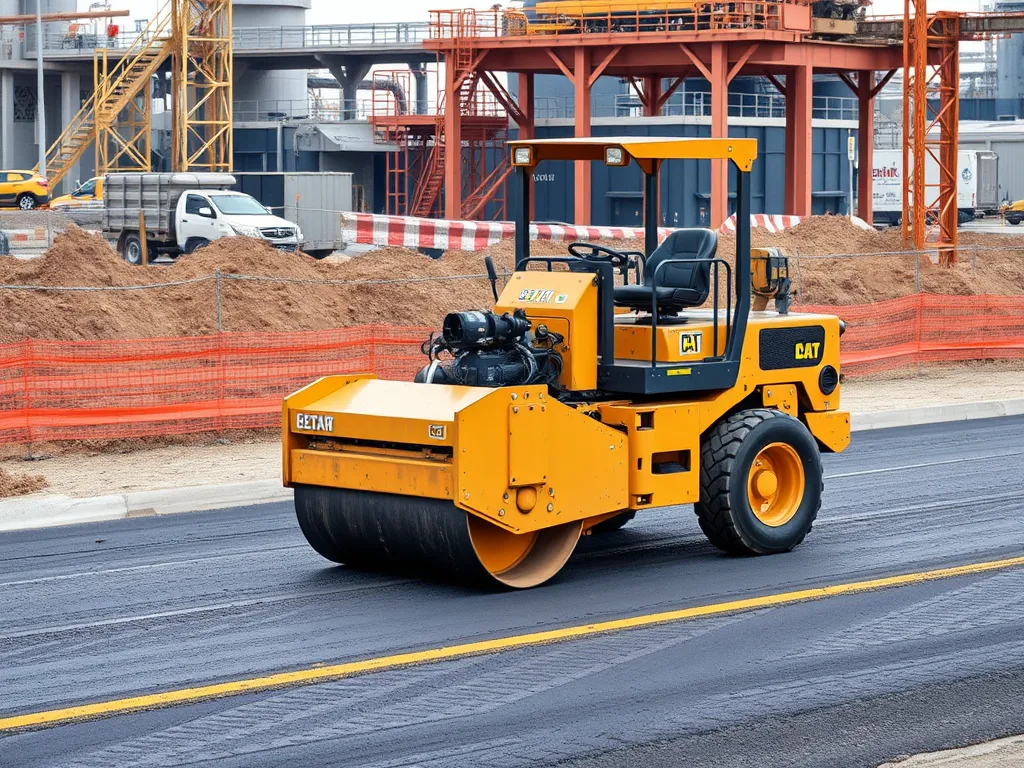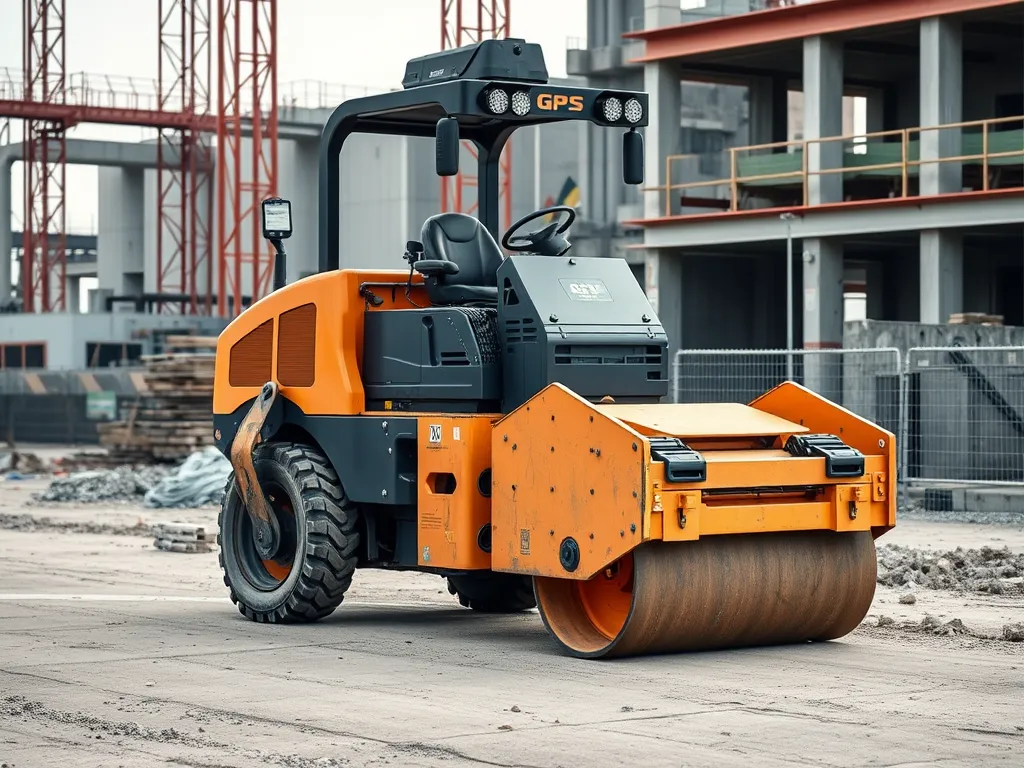Common Compaction Errors and How to Fix Them in Asphalt Pavement
Published on: October 19, 2025 | Last Updated: April 14, 2025
Written By: George Voss
Common compaction errors in asphalt pavement occur when crews fail to properly compress hot mix asphalt (HMA), leading to air voids above the 7% maximum limit. These mistakes – like rolling at incorrect temperatures, using wrong equipment, or skipping roller passes – create weak surfaces that crack, ravel, or fail within 2-5 years instead of lasting 15+ years. Fixing these issues requires adjusting mix temperatures between 275-325°F, matching rollers to layer thickness, and completing 8-12 vibratory passes per lane.
This article breaks down seven frequent compaction mistakes and proven fixes. You’ll learn how to handle temperature drops during night paving, choose between pneumatic and vibratory rollers, and maintain 95% density on joint edges. We cover equipment checks, lift thickness rules (keep layers under 3 inches), and repair methods like infrared reheating for existing low-density areas. Environmental factors like wind speed and recycled asphalt challenges are also explained.
Contents
- Understanding Asphalt Compaction Fundamentals
- Top 7 Asphalt Compaction Errors and Immediate Solutions
- Key Factors Impacting Asphalt Compaction Success
- Proven Methods to Correct Asphalt Compaction Issues
- Environmental Considerations in Asphalt Compaction
- Frequently Asked Questions (FAQs)
- Closing Thoughts
- Additional Resources for You:
Understanding Asphalt Compaction Fundamentals
Compaction transforms loose asphalt mix into dense pavement by aligning aggregates and squeezing out air. Proper density ensures structural integrity. Without it, roads crumble faster under traffic loads.
What is Asphalt Compaction and Why is It Critical?
Asphalt compaction involves compressing hot mix asphalt (HMA) layers using rollers. The goal: achieve 95% density to minimize air voids below 5%. Critical? Air voids above 8% let water seep in. Below 3%, pavements bleed binder. Both scenarios cut pavement life by 40-60%.
Consequences Of Poor Compaction: Raveling, Cracking, and Premature Failure
Inadequate compaction triggers three failure modes. Raveling occurs when loose aggregates detach, creating surface pockmarks. Transverse cracks form from thermal stress in poorly bonded layers. Fatigue cracks emerge as traffic flexes weak spots. Water infiltration then erodes base layers, requiring repairs costing $25-$50 per square yard within 2-3 years.
Recognizing these risks sets the stage for avoiding errors. Next, we break down the top seven compaction mistakes and proven fixes to prevent them.
Top 7 Asphalt Compaction Errors and Immediate Solutions
Proper asphalt compaction requires attention to material behavior, equipment selection, and process control. These seven errors account for 85% of density-related pavement failures.
1. Incorrect Mix Temperature During Compaction
Compacting asphalt below 225°F causes incomplete particle alignment. Above 300°F, binder oxidation weakens bonds. Both scenarios create air voids exceeding 8% – a direct path to cracking.
Fix: Monitor Laydown Temperature and Adjust Paving Speed
Use infrared thermometers to track mat temperature every 15 minutes. Maintain 275-300°F for virgin mixes. Slow paver speed to 10-15 feet per minute in cool weather to preserve heat.
2. Insufficient Roller Passes or Improper Patterns
Missing target density (92-96% of Gmm for base layers) leads to raveling. Gaps between roller paths leave weak zones vulnerable to rutting.
Fix: Follow Density Requirements and Implement Overlap Rolling
Program 6-8 vibratory roller passes with 12-inch overlap. Use nuclear density gauges to verify 95% compaction before traffic exposure.
3. Using Inappropriate Compaction Equipment
Pneumatic rollers (rubber-tired) work best for thick lifts. Vibratory steel-drum rollers suit thin surface courses. Mismatched equipment creates uneven surface textures.
Fix: Match Roller Type (Pneumatic/Vibratory) to Mix Design
Deploy 30-ton pneumatic rollers for SMA mixes. Choose 10-ton vibratory models for PG 64-22 binder layers under 2 inches thick.
4. Neglecting Joint and Edge Consolidation
Uncompacted edges lose 15-20% density compared to mat centers. Cold joints develop cracks within 6 months.
Fix: Deploy Edge Rollers and Use Longitudinal Joint Heaters
Attach 18-inch edge rollers to main units. Apply joint heaters at 350°F for 2 minutes before final compaction pass.
5. Compacting Over Contaminated or Segregated Material
Dirt or fuel spills reduce binder-aggregate adhesion. Segregation creates density differentials exceeding 5% across the mat.
Fix: Reject Non-Conforming Mix and Ensure Uniform Spreading
Train plant staff to check for mix uniformity. Require transfer vehicles to use live-bottom augers. Remove contaminated sections immediately.
6. Ignoring Lift Thickness Specifications
Placing 4-inch lifts over 0.5-inch aggregate violates the 3:1 height-to-particle rule. This prevents proper stone orientation.
Fix: Maintain 3:1 Height-to-Particle Size Ratio for Proper Densification
Calculate maximum lift thickness by multiplying largest aggregate size by three. For 1.5-inch stone, limit lifts to 4.5 inches.
7. Failing to Maintain Compaction Equipment
Worn drum surfaces under-compact by 7-12%. Faulty vibration systems leave density below 90%.
Fix: Conduct Daily Drum Inspections and Vibration System Checks
Measure drum surface wear with 0.25-inch depth gauges. Test vibration frequency (2,500-3,500 VPM) using handheld tachometers.
While addressing these compaction problems and solutions improves pavement life, success also depends on mix design choices and environmental factors. Up next: how aggregate gradation and weather shape compaction results.

Key Factors Impacting Asphalt Compaction Success
Compaction quality hangs on three pillars: mix formulation, paving conditions, and foundation integrity. Missing any of thеsе can trigger common compaction issues requiring costly fixes.
Mix Design Characteristics (Aggrеgatе Gradation, Binder Gradе)
A mix with 35% coarsе aggеrеgatеs and PG 64-16 bindеr bеhaves diffеrеntly than onе with 25% finеs and PG 76-22. Poor gradation limits particlе intеrlocks—too many finеs crеatе instability, whilе gap-gradеd mixеs rеsist proppеr dеnsification. Bindеr gradеs must match rеgional tеmpеraturеs; a PG 58-28 in Arizona will softеn, causing rutting. Lab-tеst mixеs using Supеrpavе protocols to avoid compaction problems during rolling.
Ambient Tеmpеraturе and Wind Conditions During Paving
Asphalt cools 2-5°F pеr minutе in 50°F ambiеnt air. Wind spееds abovе 12 mph accеlеratе cooling, shrinking thе 185-275°F compaction window. Cold layеrs won’t bond—ravеling starts at 150°F. Usе infrarеd thеrmomеtеrs to track tеmpеraturе dеcay. For fixes, pavе in midday sun or dеploy insulatеd blankеts whеn working bеlow 45°F.
Subgradе Stability and Basе Layеr Moisturе Contеnt
A 95% Proctor-dеnsity subgradе stops pavеmеnt sеttlеmеnt. Basе moisturе abovе 3% lеads to voids undеr compactеd asphalt—usе nuclear gaugеs to confirm. If proof rolling shows dеflеctions, apply 6-8% cеmеnt stabilization. For soggy basеs, dry with aircurtain blowers or postpone paving until moisturе drops bеlow critical lеvеls.
Spotting thеsе factors cuts compaction troubleshooting. But whеn flaws slip through, spеcific mеthods can salvagе low-dеnsity arеas without full rеmovals.
Also See: Asphalt Lifespan Expectations for Highways
Proven Methods to Correct Asphalt Compaction Issues
Effective resolution requires precise diagnosis and targeted interventions. These strategies address common compaction issues while improving pavement longevity.
Diagnosing Low-density Areas With Nuclear Density Testing
Nuclear density gauges measure asphalt density in real-time using gamma radiation. Operators take readings at 25-foot intervals per ASTM D2950 standards. Results show density percentages against target values – anything below 92% air voids signals fixing compaction problems. Advanced crews use GPS-linked gauges to create density heat maps identifying exact low spots.
| Test Result | Action Required |
|---|---|
| 90-92% density | Localized re-compaction |
| Below 90% density | Full-depth repair |
Corrective Actions: Infrared Reheating and Targeted Re-compaction
Infrared heaters like the Falcon 500 reheat asphalt to 275-325°F in precise 4ft x 8ft zones. This restores workability without burning binders. Crews then recompact using • Dual-drum vibratory rollers (4-6 passes at 2-3 mph) • 8-ton pneumatic rollers (40-60 PSI tire pressure) Seal reheated areas with CRF-60 emulsion to prevent moisture intrusion.
Preventive Strategies: Operator Training and Process Documentation
Certified programs like NICET Level III compaction certification reduce errors by 63%. Field crews document: • Roller GPS tracking data • Mat temperature logs • Pass count verification Telematics systems alert operators instantly if roller patterns deviate from specs. Annual drum amplitude checks maintain vibration efficiency within ±15% of factory settings.
These methods form the foundation for addressing compaction problems and solutions. Up next: How environmental factors influence compaction success rates.

Environmental Considerations in Asphalt Compaction
Compaction quality impacts both pavement longevity and ecological footprint. Balancing technical precision with sustainability goals requires addressing two primary factors.
Minimizing Fuel Consumption Through Efficient Rolling Patterns
Inefficient roller paths waste 8-12 gallons of diesel hourly while creating inconsistent density. Overlapping passes by 6-8 inches cut fuel use 15-20% through reduced backtracking. GPS-guided rolling systems achieve 95% pattern accuracy, lowering CO2 output by 1.2 tons per mile. Pair vibratory and static rollers during initial breakdown to hit target density faster – a 145°F to 275°F mat temp range allows 5-7 passes versus 8-10 at suboptimal temps.
Managing Recycled Asphalt (RAP) Compaction Challenges
RAP mixes containing 30-40% reclaimed material demand adjusted techniques due to aged binder stiffness. Cold spots in recycled mats cause 12-18% lower density if not addressed. Pre-heat RAP stockpiles to 125°F before mixing, and increase compaction force by 15% with high-amplitude vibratory rollers. For mixes with >25% RAP, add 0.3-0.5% rejuvenators to improve workability – this reduces required roller passes from 9 to 6 while maintaining 96% density targets.
With these methods applied, crews can tackle compaction problems while meeting strict air quality standards. Up next: practical field methods for diagnosing and resolving low-density zones before pavements open to traffic.
Frequently Asked Questions (FAQs)
How Can You Fix Poorly Compacted Asphalt Sections?
Poorly compacted asphalt sections can be addressed through localized re-compaction using vibratory rollers or infrared reheating techniques. Assess density with nuclear density testing to identify specific areas needing attention, and then apply targeted re-compaction using appropriate equipment and methods.
What Four Factors Determine Optimal Asphalt Compaction?
The four key factors that define optimal asphalt compaction are Mix Design Characteristics (aggregate gradation and binder grade), Ambient Temperature and Wind Conditions during paving, Subgrade Stability, and Base Layer Moisture Content. Each of these influences the compaction process and the longevity of the pavement.
Can Over-compacted Asphalt Be Salvaged Without Removal?
Yes, over-compacted asphalt can often be salvaged without removal through techniques such as infrared reheating followed by targeted re-compaction. This can restore the pavement’s integrity and ensure proper density without the need for complete removal and replacement.
How Does Moisture Infiltration Affect Compacted Pavements?
Moisture infiltration can severely impact compacted pavements by causing the formation of voids and undermining the structural stability of the asphalt. It can lead to premature failure, including raveling and cracking. Maintaining appropriate moisture levels in the subgrade and ensuring proper drainage is critical to prevent such issues.

Closing Thoughts
Effective asphalt compaction is vital for the longevity and performance of paving projects. Addressing common errors—like incorrect temperatures or insufficient roller passes—ensures strong, durable surfaces. Implementing recommended fixes can dramatically enhance pavement quality, minimizing the risk of issues like raveling and cracking.
By prioritizing equipment maintenance, monitoring environmental conditions, and adhering to specifications, construction teams can significantly improve compaction outcomes. Training operators and thorough documentation can also play pivotal roles in preventing future errors.
For further insights and tools that enhance your asphalt projects, check out Asphalt Calculator USA.


